


This article highlights ten essential treatments for managing Peripheral Artery Disease (PAD) in seniors, emphasizing a compassionate, multidisciplinary approach that includes medical, surgical, and lifestyle interventions. It is crucial to understand the concerns of older adults facing PAD, and this article aims to address those feelings with empathy and care.
Personalized care is at the heart of effective PAD management. By incorporating minimally invasive procedures, medication management, lifestyle modifications, and community support, we can enhance health outcomes for older adults. In addition to this, it is important to recognize that every individual’s journey is unique, and tailored approaches can make a significant difference in their quality of life.
Furthermore, the article reassures readers that they are not alone in this journey. Community support plays a vital role in fostering a sense of belonging and encouragement. We invite you to reflect on how these treatments can not only improve physical health but also promote emotional well-being. If you or a loved one is facing PAD, seeking help is a courageous step towards a healthier future. Remember, there is always support available to guide you through this process.
Peripheral Artery Disease (PAD) is a chronic condition that can present significant challenges, particularly for seniors as they navigate their health. With the potential to greatly affect mobility and overall quality of life, it is vital to understand effective treatments available. This article will explore ten essential therapies specifically tailored for older adults, demonstrating how a comprehensive approach can enhance health outcomes and promote greater independence.
How can seniors manage PAD effectively while addressing their unique health needs? The following insights aim to illuminate the path toward better health and well-being, offering reassurance and support every step of the way.
At Amavita Heart and Vascular Health, we understand the concerns surrounding Peripheral Artery Disease (PAD) and are dedicated to providing comprehensive peripheral artery disease treatments tailored to your needs. Our advanced diagnostic techniques and personalized treatment plans are designed with you in mind. By employing a multidisciplinary approach, we seamlessly combine medical, surgical, and lifestyle interventions to enhance your health outcomes. This approach is especially beneficial for seniors, who often encounter unique challenges in managing PAD.
We focus on minimally invasive techniques, such as balloon angioplasty and stenting, as these are effective peripheral artery disease treatments that can lead to shorter recovery periods and an improved quality of life. Under the compassionate guidance of Dr. Pedro Martinez-Clark, our team prioritizes your comfort and well-being, recognizing the importance of addressing both your medical and emotional needs as you navigate your wellness journey.
We invite you to reach out and discuss how we can . Remember, you are not alone in this journey; we are here to help you every step of the way.
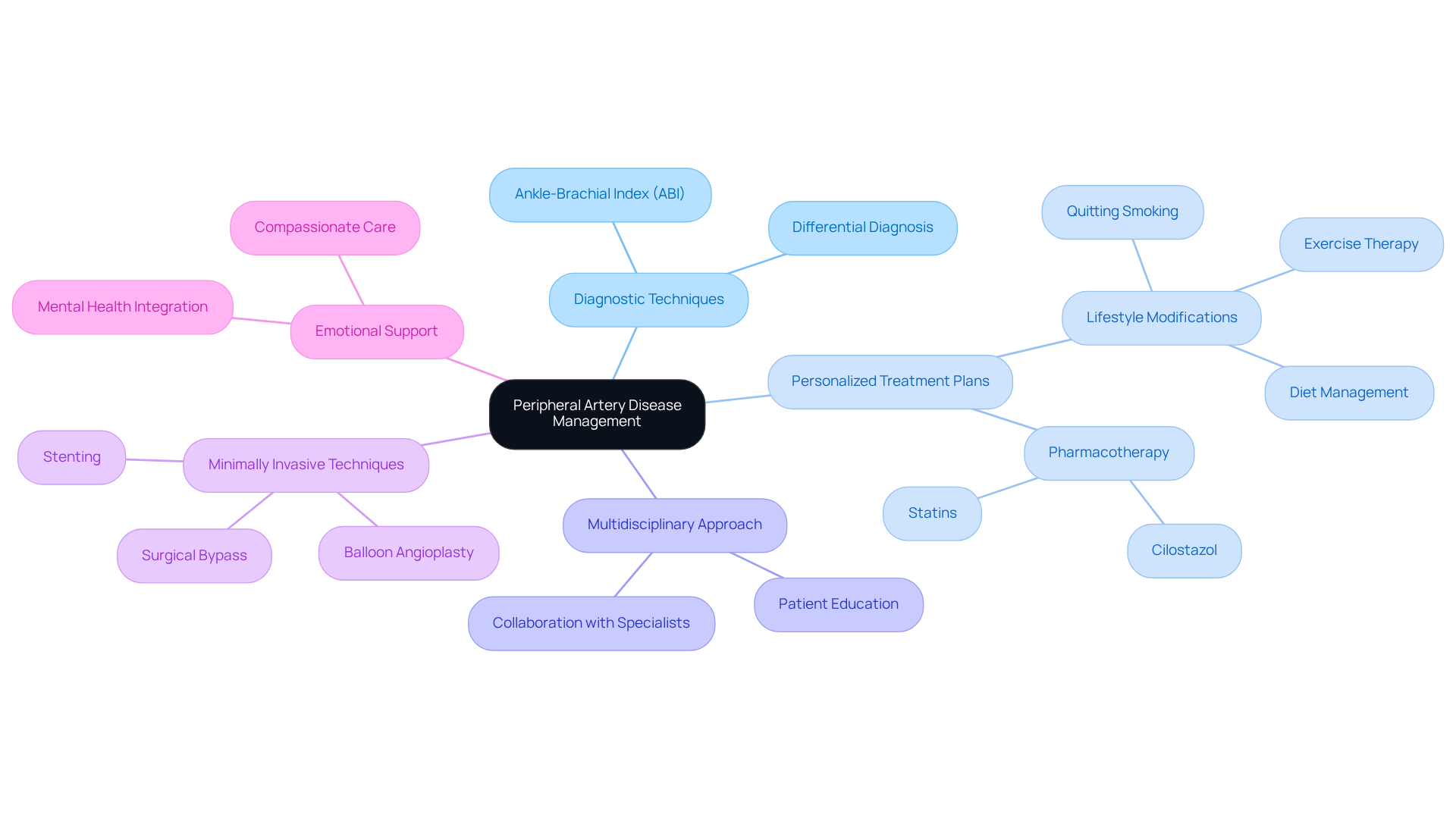
Medications play a vital role in peripheral artery disease treatments, particularly for older individuals who often face various health challenges. Antiplatelet agents, such as aspirin and clopidogrel, serve as foundational therapies that help prevent blood clots and enhance blood flow. This significantly , providing peace of mind. Recent studies have highlighted the effectiveness of these agents in real-world settings, demonstrating their crucial role in improving outcomes for individuals.
Statins are commonly prescribed to lower cholesterol levels, further alleviating cardiovascular risks associated with PAD. Their benefits are particularly notable in older adults, as they assist in managing lipid profiles and reducing the likelihood of heart-related complications. This proactive approach can lead to a healthier future.
Cilostazol, a vasodilator, is an important medication among peripheral artery disease treatments that alleviates symptoms of claudication, enabling individuals to walk longer distances without pain. This improvement in mobility can greatly enhance the quality of life for those affected by PAD, allowing them to engage more fully in daily activities.
At Amavita Heart and Vascular Health, we utilize advanced imaging capabilities to tailor medication management to the unique needs of individuals at high risk. Regular monitoring and adjustments of these medications are essential, especially for older individuals who may have varying responses due to comorbidities. Our cardiologists emphasize the importance of a customized strategy for medication management, ensuring that each individual's treatment plan aligns with their specific health requirements and lifestyle.
Furthermore, the Auryon Atherectomy System, evaluated in the PATHFINDER Registry, offers innovative peripheral artery disease treatments for complex cases of PAD, enhancing overall care. By prioritizing effective medication strategies and advanced peripheral artery disease treatments, healthcare providers can significantly improve the management of peripheral artery disease (PAD) and promote overall individual well-being. We are here to support you every step of the way.

Lifestyle modifications are essential in the context of peripheral artery disease treatments, especially for seniors. A heart-healthy diet rich in fruits, vegetables, whole grains, and lean proteins is crucial for lowering cholesterol levels and improving vascular health. Nutritionists highlight that these dietary choices can profoundly affect overall cardiovascular well-being, reducing the risk of complications associated with PAD. For example, the Mediterranean diet, which includes nuts and polyunsaturated fats, has been linked to a lower incidence of PAD.
Regular exercise is just as important. Current recommendations suggest that older individuals with PAD aim for at least 150 minutes of moderate exercise or 75 minutes of vigorous exercise each week, ideally spread across most days. have proven particularly effective, as they not only enhance circulation but also help alleviate symptoms of claudication. Furthermore, home-based walking exercise interventions that incorporate behavioral change techniques have demonstrated significant improvements in walking ability compared to supervised treadmill exercise. Gradually increasing the intensity of exercise as tolerated is vital for maximizing benefits.
Successful diet and exercise programs for seniors often include behavioral change techniques as part of peripheral artery disease treatments, which encourage adherence to these lifestyle modifications. By committing to these changes, individuals can experience improved PAD symptoms and a better overall quality of life. Remember, you are not alone on this journey; support is available, and taking these steps can lead to a healthier, more fulfilling life.
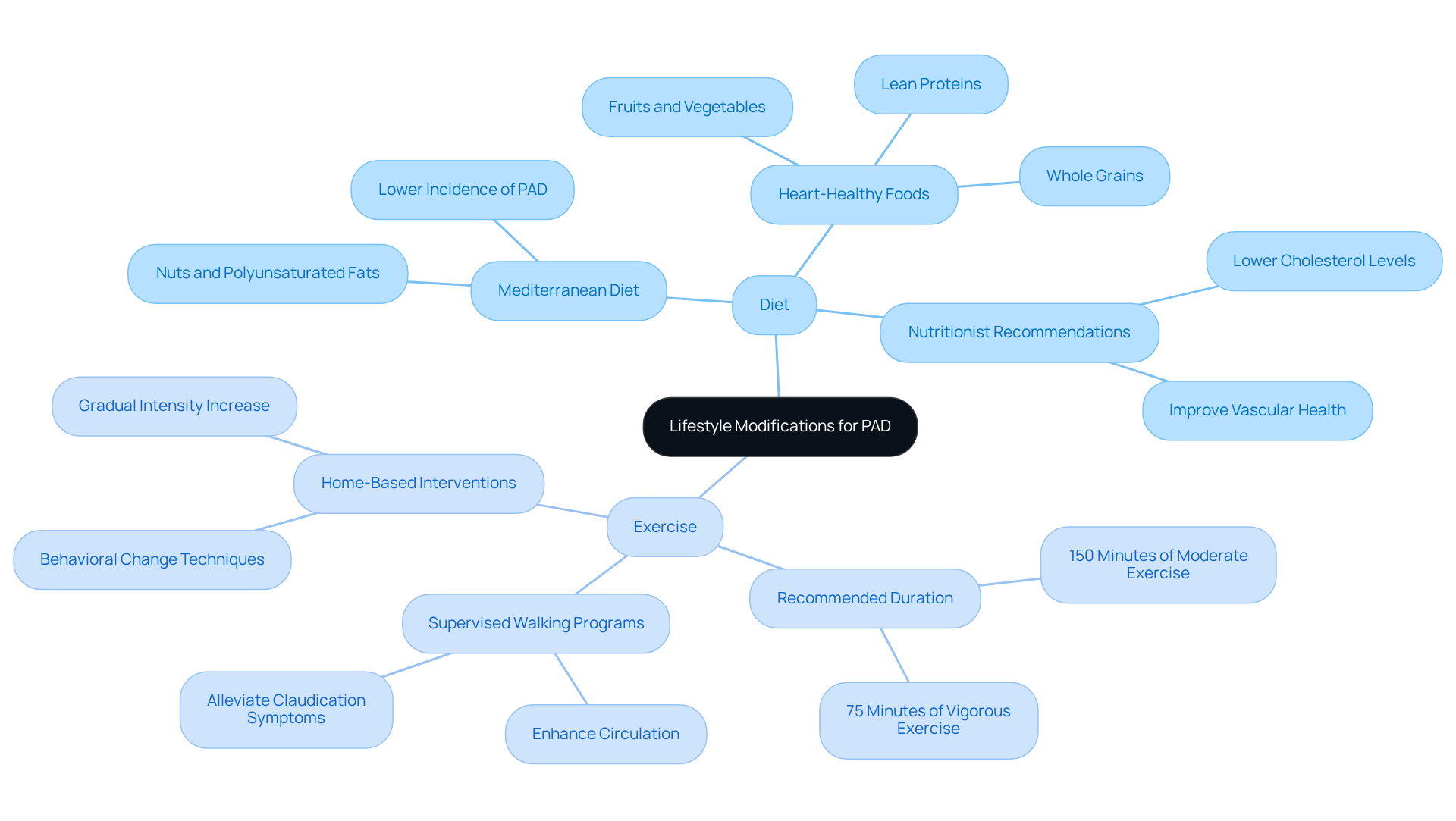
Quitting smoking is one of the most powerful steps you can take to improve your health if you have Peripheral Artery Disease (PAD). Smoking not only speeds up the progression of atherosclerosis but also significantly increases the risk of cardiovascular events. It's concerning to note that research shows up to 80% of PAD patients are current or former smokers, highlighting the critical need to address this modifiable risk factor. If you currently smoke more than a pack a day, your risk of developing PAD is 5.4 times higher than that of never-smokers. Health professionals want you to know that quitting smoking can lead to significant improvements in symptoms like leg pain, cramping, and fatigue during activity, which often ease with rest. For example, studies indicate that individuals who stop smoking can significantly lower their risk of PAD complications within five years, with a remarkable 57 percent reduction in risk after 5 to 9 years of cessation.
To support seniors in their journey to quit smoking, there are many resources available, including:
These interventions not only assist in quitting but also enhance long-term well-being, making smoking cessation a top priority in the context of peripheral artery disease treatments. Furthermore, at Amavita Heart and Vascular Health, our compassionate experts use advanced diagnostic imaging to identify blockages and offer peripheral artery disease treatments such as minimally invasive procedures like venous ablation and sclerotherapy to restore circulation. This can significantly improve your walking distance and reduce pain.
Additionally, initiatives like the Society for Vascular Surgery's CAN-DO program provide valuable resources to help individuals reduce tobacco use and improve their health. Remember, you are not alone in this journey; , and taking that first step can lead to a healthier, more fulfilling life.

Efficient diabetes control is crucial for individuals undergoing peripheral artery disease treatments. Elevated glucose levels can significantly worsen vascular damage and increase the risk of complications, including a fourfold higher chance of amputation for those facing both conditions. It's important for elderly individuals to collaborate closely with their healthcare teams to monitor glucose levels and adhere to prescribed diabetes medications. Research has shown that not only slows the progression of peripheral artery disease but also aids in the effectiveness of peripheral artery disease treatments by mitigating complications like slow-healing wounds.
Making lifestyle changes can play a vital role in regulating sugar levels. Adopting a balanced diet, engaging in regular physical activity, and practicing proper foot care are essential steps. Many patients have experienced improved outcomes from peripheral artery disease treatments, such as enhanced mobility and reduced symptoms, by actively managing their diabetes. At Amavita Heart and Vascular Health, our specialists utilize advanced diagnostic imaging to identify blockages and offer minimally invasive procedures that restore circulation, significantly improving walking distance and alleviating pain.
Endocrinologists emphasize that consistent glucose regulation is not just beneficial; it is essential for maintaining vascular health and preventing further complications associated with peripheral artery disease treatments. Remember, you are not alone in this journey. Our team is here to support you every step of the way, ensuring you receive the care and understanding you deserve.
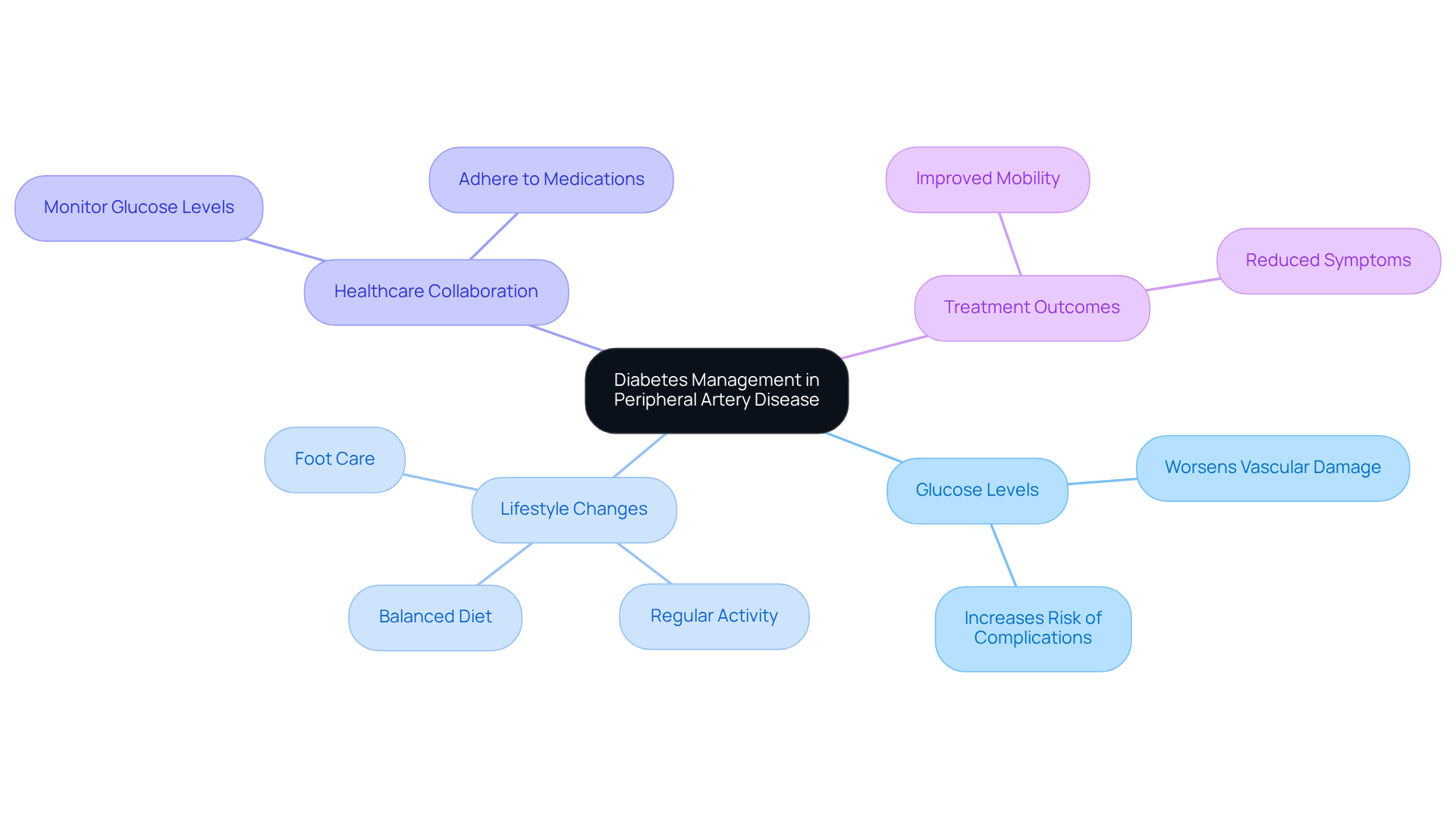
For individuals facing the challenges of advanced Peripheral Artery Disease, it’s important to know that peripheral artery disease treatments, including surgical procedures, may be necessary to restore circulation. You might find comfort in understanding that common peripheral artery disease treatments include:
Furthermore, the Auryon Atherectomy System has emerged as a promising option for peripheral artery disease treatments, particularly for treating complex lesions, including severe calcifications and chronic total occlusions, as evaluated in the PATHFINDER Registry. This innovative technology utilizes a 355 nm fiber laser, demonstrating both precision and safety in . The findings from the registry suggest notable enhancements in symptoms and quality of life for individuals who have not responded to peripheral artery disease treatments.
At Amavita Heart and Vascular Health, we emphasize individualized care and same-day convenience, enabling the majority of individuals to return home after procedures. This approach ensures a smooth recovery process, allowing you to feel supported every step of the way. Remember, you are not alone in this journey, and we are here to help you regain your health and well-being.

Foot care is essential for individuals with Peripheral Artery Disease (PAD), particularly since up to 20% of those over 70 are affected by this condition. Reduced blood flow can lead to serious complications, such as ulcers and infections, which can be concerning. Daily foot inspections are crucial; it’s important to look for any signs of injury, redness, or swelling. Keeping feet clean and moisturized is vital, along with wearing well-fitting shoes to prevent blisters and other injuries. Regular visits to a podiatrist can make a significant difference in managing foot health and preventing complications. These specialists are equipped to provide that cater to your needs. As John N. Evans, chief of podiatry at Beaumont Hospital, wisely states, "If you see something that’s not quite right, let your care specialist know that there’s something going on right away."
Instruction on appropriate foot care practices is especially important for older individuals, who may have diminished sensation in their feet, increasing their risk of unnoticed injuries. Additionally, managing PAD effectively can help mitigate costs, as medications for mild PAD can range from $50 to $300 per month without insurance. By prioritizing foot care, you can significantly reduce the likelihood of complications associated with peripheral artery disease treatments. Remember, you are not alone in this journey; reaching out for support can lead to better health outcomes and peace of mind.
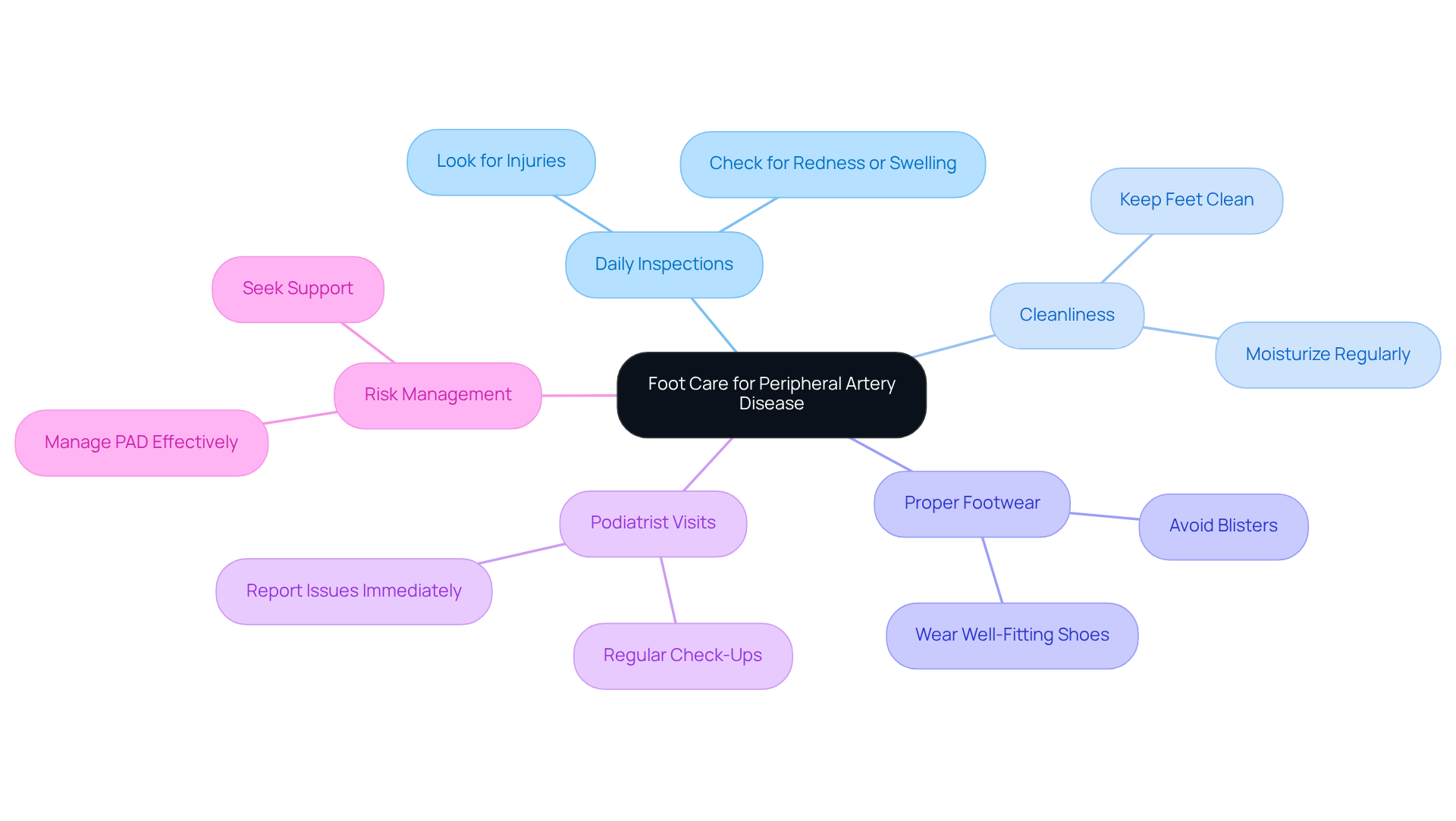
Recognizing the symptoms and risk factors of Peripheral Artery Disease (PAD) is crucial for early diagnosis and peripheral artery disease treatments. Many individuals experience leg pain or cramping during physical activity, known as claudication, along with numbness and slow-healing wounds. These symptoms may signal underlying issues, such as due to plaque buildup, which can severely limit mobility if left untreated. Risk factors include:
At Amavita Heart and Vascular Health®, we understand how concerning these symptoms can be, and we emphasize the importance of proactive discussions with your healthcare provider. Have you considered reaching out to discuss any troubling signs? Our specialists utilize advanced diagnostic imaging to identify blockages and offer expert peripheral artery disease treatments, including minimally invasive procedures that can restore blood flow.
Early intervention can significantly alter the course of the disease and improve your quality of life. Remember, you are not alone in this journey; we are here to support you every step of the way. Don't hesitate to seek help—your health and well-being are our top priority.
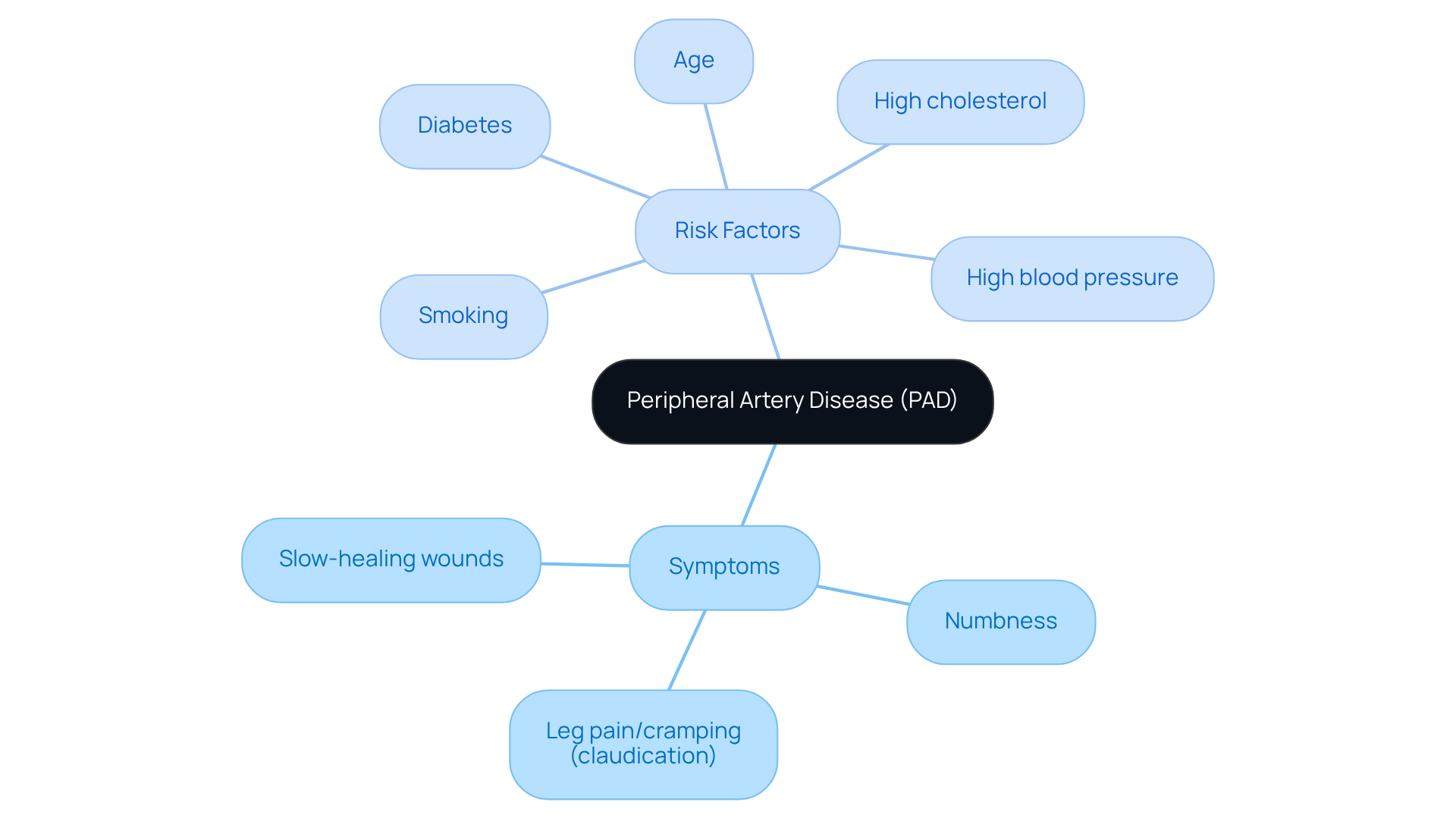
Community outreach plays a vital role in raising awareness about Peripheral Artery Disease (PAD). Initiatives like wellness fairs and educational seminars, often conducted in partnership with local organizations, provide effective platforms for sharing essential information about PAD, including its symptoms and risk factors. By involving the community in these efforts, we can inspire individuals to seek timely medical care, ultimately improving their health outcomes.
Furthermore, initiatives that prioritize culturally sensitive communication have proven especially effective across diverse communities, ensuring that everyone receives vital information tailored to their backgrounds. Data indicates that wellness fairs and educational seminars can significantly boost awareness of PAD, empowering participants to take charge of their health and engage in preventive measures.
Public health officials highlight the importance of these educational initiatives in bridging the knowledge gap surrounding PAD. By addressing this gap, we can foster better management and outcomes for those affected. Remember, you are not alone in this journey; are available to help you navigate your health concerns with confidence and care.

Clinical trials play a vital role in advancing peripheral artery disease treatments as well as addressing Chronic Venous Insufficiency (CVI). At Amavita Heart and Vascular Health®, we conduct studies that assess new therapies, devices, and treatment protocols, all aimed at providing better outcomes for individuals like you. If you experience symptoms of PAD, such as pain, cramping, or fatigue in your legs during activity—symptoms that improve with rest—you may find comfort in knowing that there are options available. Similarly, CVI can lead to swelling, pain, and visible varicose veins, which can be distressing.
Participating in clinical trials can offer you access to innovative therapies, including peripheral artery disease treatments and minimally invasive procedures designed to restore blood flow or close problematic veins, which may not yet be widely available. This commitment to advancing cardiovascular care through clinical research reflects our dedication to your health and well-being.
If you are interested in exploring clinical trials, we encourage you to discuss your options with your healthcare provider. They can guide you on eligibility and the potential benefits and risks involved. Remember, engaging in research not only contributes to your personal health but also helps advance medical knowledge for future patients. You are not alone on this journey; we are here to every step of the way.
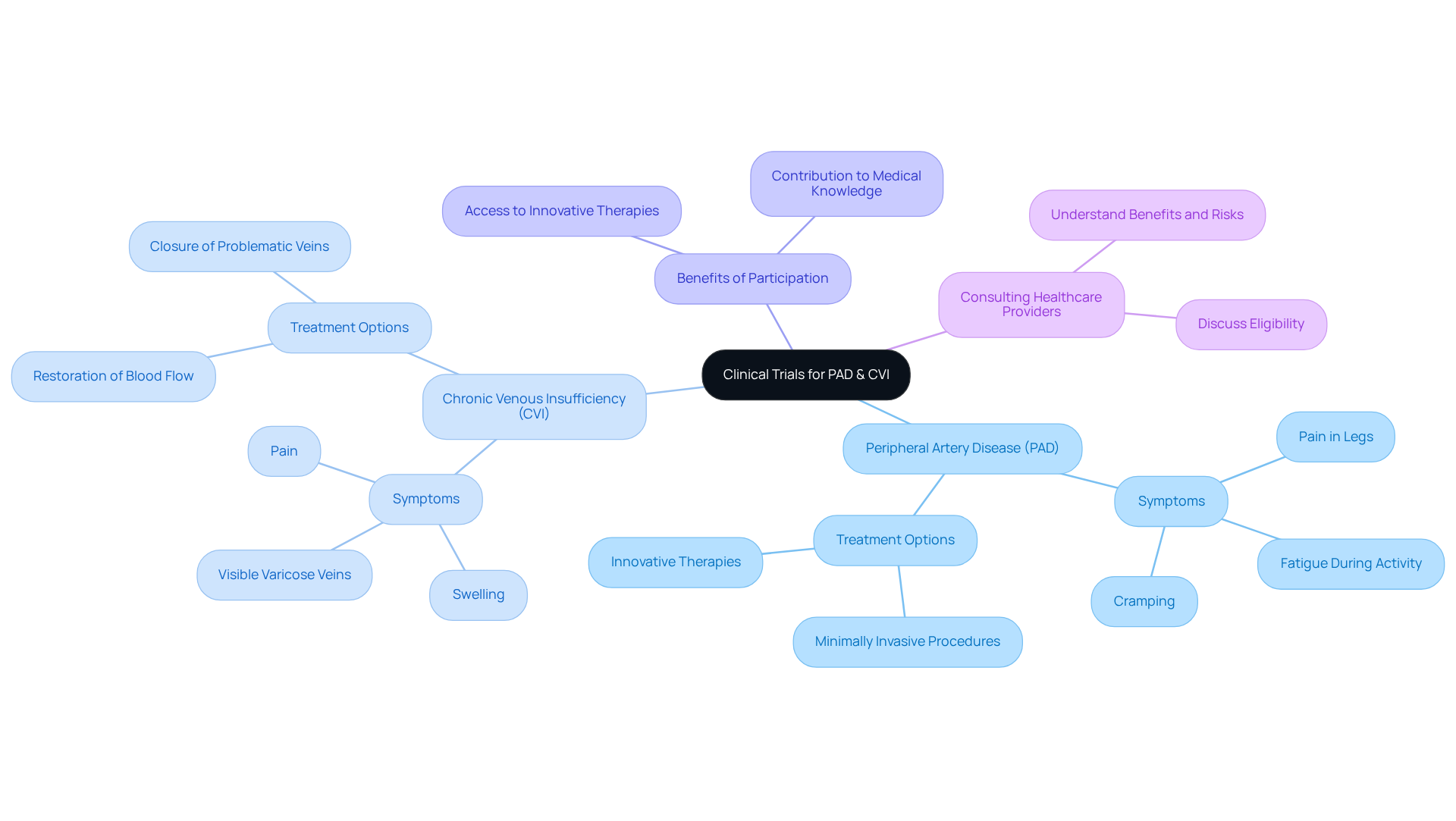
Understanding and managing Peripheral Artery Disease (PAD) is essential for seniors who wish to enhance their health and quality of life. This article has outlined a comprehensive range of treatments, highlighting the importance of a multidisciplinary approach that encompasses medication, lifestyle modifications, and advanced surgical interventions. By focusing on individualized care, we ensure that each patient's unique needs are met, fostering better health outcomes and enhancing overall well-being.
Key insights discussed include:
In addition to this, the article emphasizes:
Each of these elements contributes to a holistic strategy for managing PAD effectively.
As the journey toward better health continues, it is vital for individuals to engage proactively with healthcare providers, seek support, and embrace lifestyle changes that can lead to significant improvements in symptoms and overall health. By prioritizing awareness and education about PAD, both patients and communities can collaborate to foster better management strategies and ultimately enhance the quality of life for those affected by this condition.
What is Peripheral Artery Disease (PAD)?
Peripheral Artery Disease (PAD) is a common circulatory problem where narrowed arteries reduce blood flow to the limbs, often leading to symptoms such as leg pain when walking.
How does Amavita Heart and Vascular Health approach PAD management?
Amavita Heart and Vascular Health employs a multidisciplinary approach that combines medical, surgical, and lifestyle interventions tailored to individual needs, focusing on minimally invasive techniques for effective treatment.
What minimally invasive techniques are used for PAD treatment?
Techniques such as balloon angioplasty and stenting are used, which can lead to shorter recovery periods and improved quality of life for patients.
What role do medications play in managing PAD?
Medications, including antiplatelet agents like aspirin and clopidogrel, statins for cholesterol management, and cilostazol for alleviating claudication symptoms, are essential in treating PAD, particularly for older individuals.
How does lifestyle modification impact PAD?
Lifestyle modifications, including a heart-healthy diet and regular exercise, are crucial for managing PAD. They can help lower cholesterol levels, improve vascular health, and enhance overall quality of life.
What dietary recommendations are beneficial for individuals with PAD?
A diet rich in fruits, vegetables, whole grains, and lean proteins, such as the Mediterranean diet, can lower cholesterol levels and reduce cardiovascular risks associated with PAD.
What exercise recommendations are suggested for seniors with PAD?
Seniors with PAD are encouraged to engage in at least 150 minutes of moderate exercise or 75 minutes of vigorous exercise weekly, ideally through supervised walking programs or home-based interventions.
How does Amavita Heart and Vascular Health customize medication management for PAD patients?
The team utilizes advanced imaging capabilities to tailor medication management to individual needs, with regular monitoring and adjustments to account for varying responses due to comorbidities.
What is the Auryon Atherectomy System?
The Auryon Atherectomy System is an innovative treatment option for complex cases of PAD, evaluated in the PATHFINDER Registry, aimed at enhancing overall care for patients.
How can individuals get support in managing PAD?
Individuals are encouraged to reach out to Amavita Heart and Vascular Health for support and guidance in managing PAD, emphasizing that they are not alone in their journey.